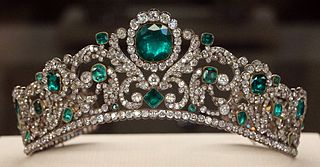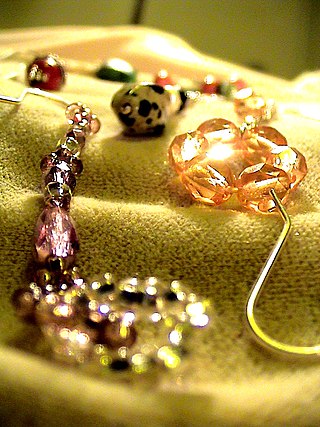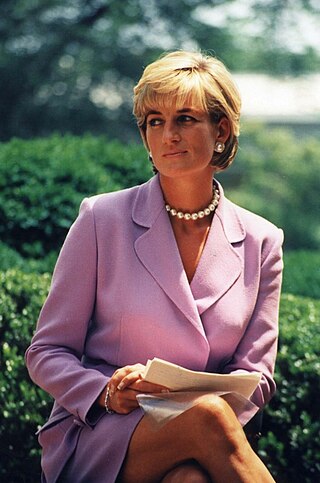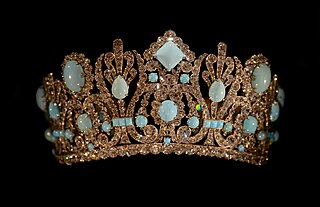
Jewellery consists of decorative items worn for personal adornment such as brooches, rings, necklaces, earrings, pendants, bracelets, and cufflinks. Jewellery may be attached to the body or the clothes. From a western perspective, the term is restricted to durable ornaments, excluding flowers for example. For many centuries metal such as gold often combined with gemstones, has been the normal material for jewellery, but other materials such as glass, shells and other plant materials may be used.

Peter Carl Gustavovich Fabergé was a Russian goldsmith and jeweller. He is best known for creating Fabergé eggs made in the style of genuine Easter eggs, but using precious metals and gemstones rather than more mundane materials. He was one of the sons of Gustav Fabergé, the founder of the House of Fabergé.

A tiara is a jeweled head ornament. Its origins date back to ancient Greco-Roman world. In the late 18th century, the tiara came into fashion in Europe as a prestigious piece of jewelry to be worn by women at formal occasions. The basic shape of the modern tiara is a semi-circle, usually made of silver, gold or platinum and richly decorated with precious stones, pearls or cameos.

A necklace is an article of jewellery that is worn around the neck. Necklaces may have been one of the earliest types of adornment worn by humans. They often serve ceremonial, religious, magical, or funerary purposes and are also used as symbols of wealth and status, given that they are commonly made of precious metals and stones.

A bracelet is an article of jewellery that is worn around the wrist. Bracelets may serve different uses, such as being worn as an ornament. When worn as ornaments, bracelets may have a supportive function to hold other items of decoration, such as charms. Medical and identity information are marked on some bracelets, such as allergy bracelets, hospital patient-identification tags, and bracelet tags for newborn babies. Bracelets may be worn to signify a certain phenomenon, such as breast cancer awareness, or for religious/cultural purposes.

Cufflinks are items of jewelry that are used to secure the cuffs of dress shirts. Cufflinks can be manufactured from a variety of different materials, such as glass, stone, leather, metal, precious metal or combinations of these. Securing of the cufflinks is usually achieved via toggles or reverses based on the design of the front section, which can be folded into position. There are also variants with chains or a rigid, bent rear section. The front sections of the cufflinks can be decorated with gemstones, inlays, inset material or enamel and designed in two or three-dimensional forms.

The Imperial crown of Russia, also known as the Great Imperial Crown of Russian Empire, was used for the coronation of the monarchs of Russia from 1762 until the Russian monarchy's abolition in 1917. The great imperial crown was first used in the coronation by Catherine the Great, and it was last worn at the coronation of Nicholas II. It was displayed prominently next to Nicholas II on a cushion at the State Opening of the Russian Duma inside the Winter Palace in St. Petersburg in 1906. It survived the 1917 revolution and ensuing civil war and is currently on display in Moscow at the Kremlin Armoury's State Diamond Fund.

A parure is a set of various items of matching jewelry, which rose to popularity in early 19th-century Europe.

The Imperial Coronation egg is a jewelled Fabergé egg made under the supervision of the Russian jeweller, Peter Carl Fabergé, in 1897 by Fabergé ateliers, Mikhail Perkhin and Henrik Wigstrom. The egg was made to commemorate Tsarina, Empress Alexandra Fyodorovna.

Elizabeth II owned a historic collection of jewels – some as monarch and others as a private individual. They are separate from the gems and jewels of the Royal Collection, and from the coronation and state regalia that make up the Crown Jewels.

The House of Bolin is one of the oldest firms specialising in jewellery and silverware that remains in the hands of its founding family. The firm exists today as Jewellers and Silversmiths to HM the King of Sweden.

The Fabergé Museum is a privately owned museum located in the German spa city of Baden-Baden exhibiting different collections, among them, items made by the Russian jewellery firm Fabergé, as well as Fauxbergé pieces. It was opened by Russian art collector Alexander Ivanov on 9 May 2009. It is owned by the private limited company Fabergé Museum GmbH, which was originally co-founded by Alexander Ivanov and Konstantin Goloshchapov in January 2008.
Mellerio dits Meller is a French jewellery house, founded in 1613, and still active today. It is the oldest family company in Europe. It gives its name to the Mellerio cut, a 57-facet jewel cut, shaped as an oval within an ellipse. Today Mellerio is based in rue de la Paix, Paris, with branches in Luxembourg and Japan. It is a member of the Comité Colbert and also of the Henokiens, an international club made up of family companies over 200 years old. Directors François and Olivier Mellerio are the fourteenth generation to run the family business.

A bijou from the French bijou is an intricate jewellery piece incorporated into clothing, or worn by itself on the body.
Fauxbergé is a term coined to generally describe items that are faking a higher quality or status and in specific terms relates to the House of Fabergé, which was a Russian jewellery firm founded in 1842 in Saint Petersburg and nationalised by the Bolsheviks in 1918. The term was first mentioned in a publication by auctioneer and Fabergé book author Archduke Géza of Austria in his article "Fauxbergé," published in Art and Auction in 1994. He also used it during the exhibition "Fabergé in America" in 1996 and subsequent later ones.

Diana, Princess of Wales, owned a collection of jewels both as a member of the British royal family and as a private individual. These were separate from the coronation and state regalia of the crown jewels. Most of her jewels were either presents from foreign royalty, on loan from Queen Elizabeth II, wedding presents, purchased by Diana herself, or heirlooms belonging to the Spencer family.

An inventory of the jewels of Mary I of England, known as Princess Mary or the Lady Mary in the years 1542 to 1546, was kept by her lady in waiting Mary Finch. The manuscript is now held by the British Library. It was published by Frederic Madden in 1831. Some pieces are listed twice. The British Library also has an inventory of the jewels she inherited on coming to the throne in 1553.
Bibi van der Velden is a Dutch jewellery designer and sculptor who uses unexpected materials and shapes in her creations. She is also the founder and creative director of Auverture, a contemporary jewellery platform.

The Marie Louise Diadem is a diamond and turquoise diadem on permanent display at the National Museum of Natural History in Washington D.C.. It is named for Marie Louise of Austria, the wife of Emperor Napoleon of France.
The joyas de pasar are a historic collection of jewels, privately owned by the head of the Spanish royal family, to be worn by the Queen of Spain on solemn occasions. The initial jewellery set was gathered by Queen Victoria Eugenie, wife of King Alfonso XIII, and are transmitted to the next generation following the instructions that she left in her will. They are separate from the Regalia of Spain which is owned by the Spanish State.

































































